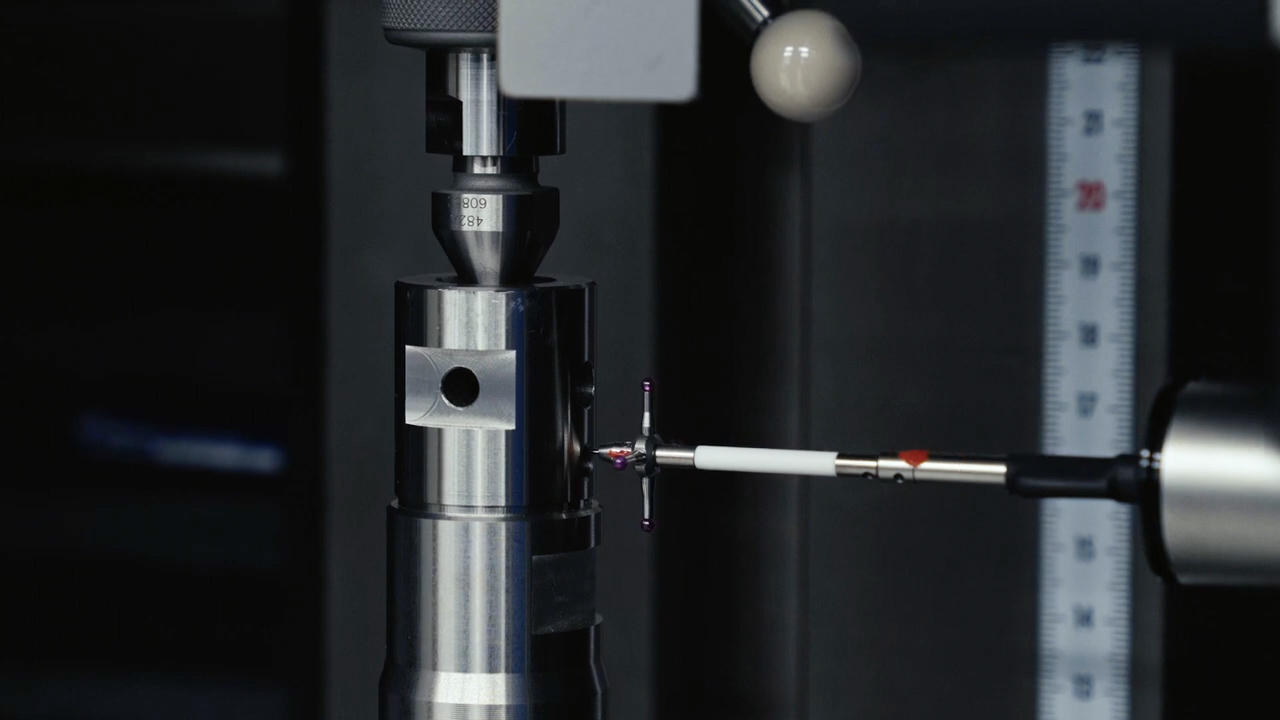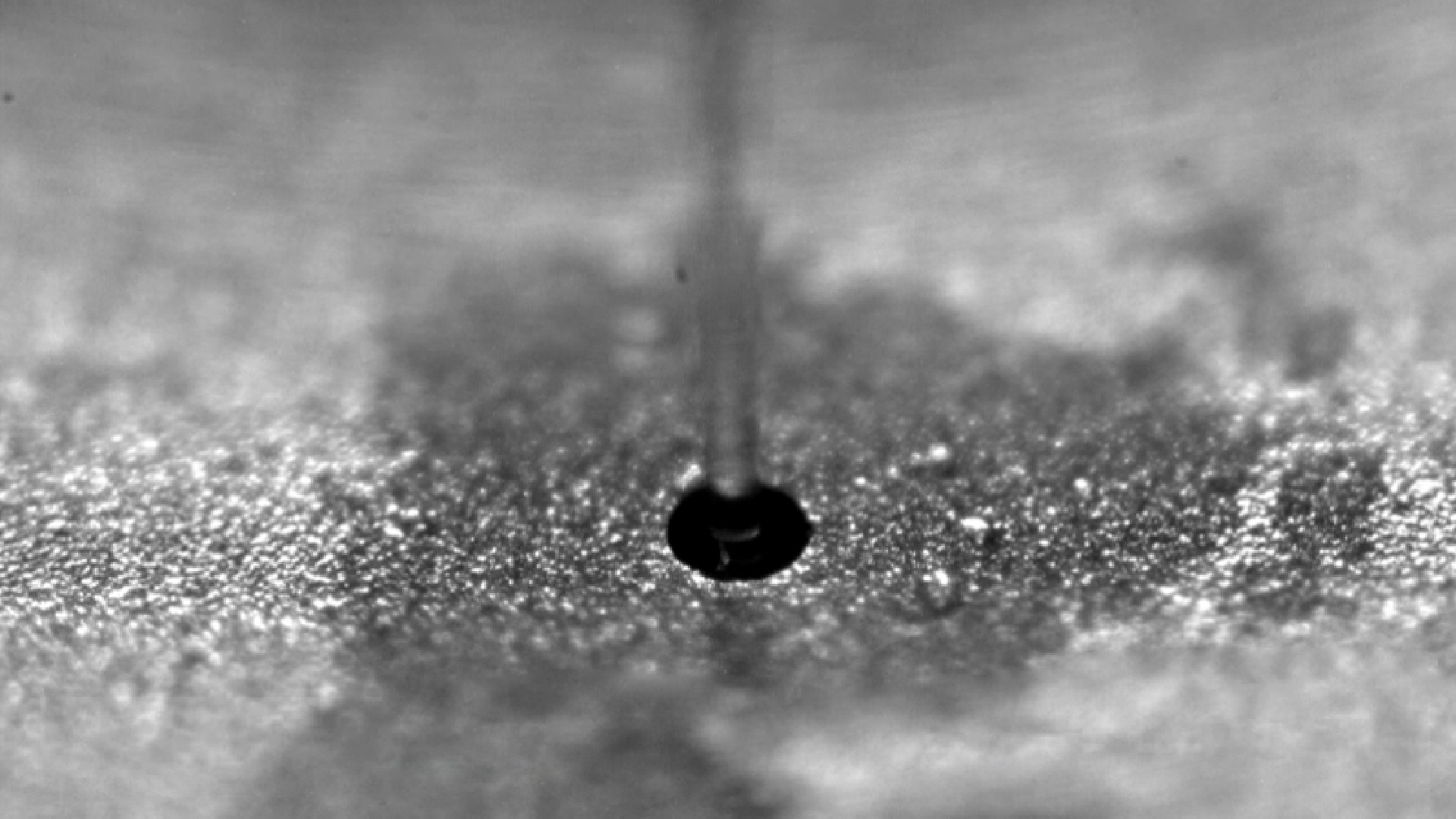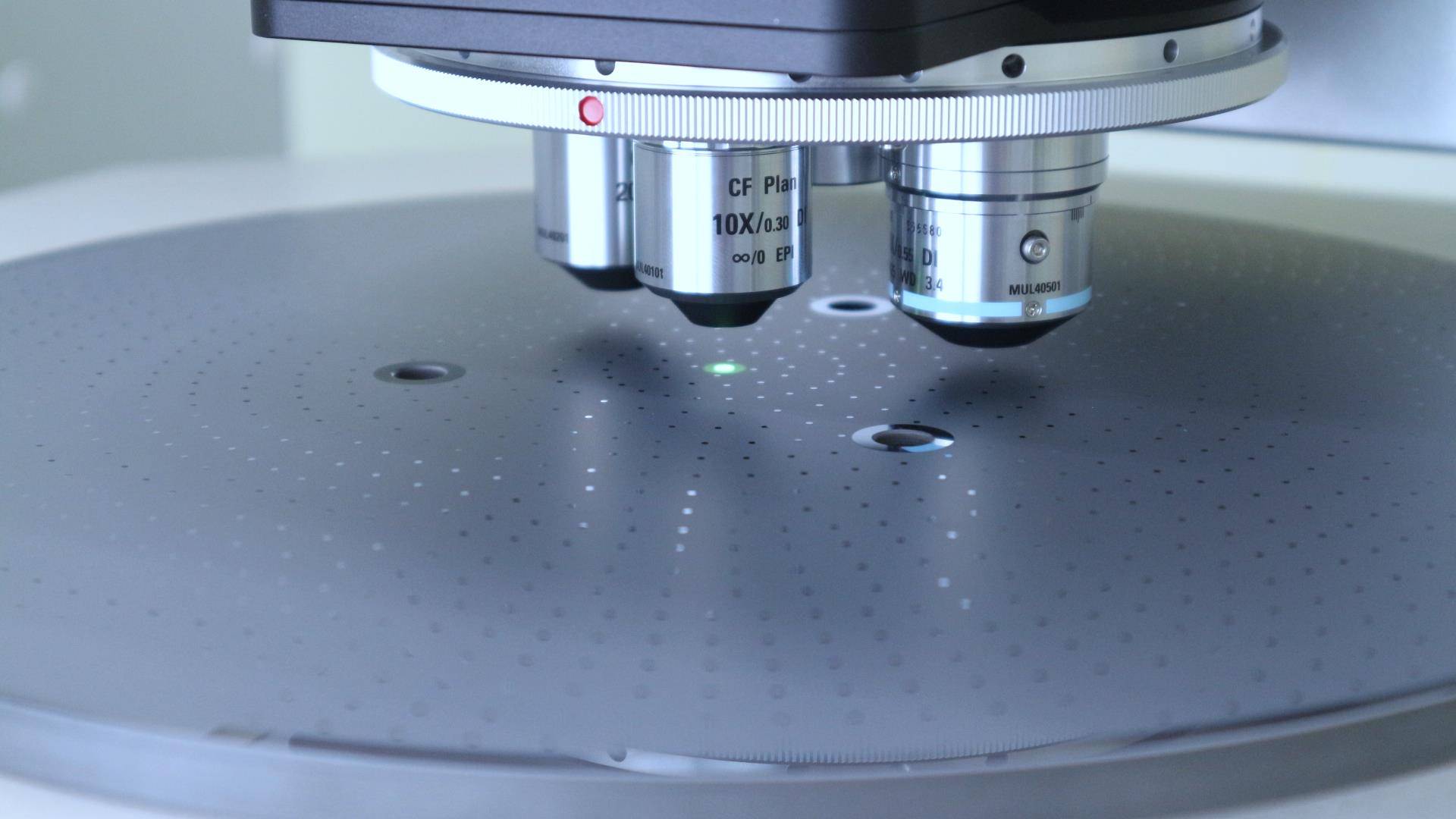
Introducing Opt-scope Rex
ACCRETECH’s Opt-scope series are white light interference microscopes that perform nano-level surface profile measurement using our proprietary high-speed, special-purpose algorithm DEAP. The latest addition to the series, Opt-scope Rex, not only offers high-accuracy measurement but also wider measurement range and significantly shorter measurement time.
Opt-scope Rex New Features

Current Model
Uses white light interference for swift, non-contact measurement of surface roughness and profiles of machined mechanical parts, etc.
New Model
Six times faster scanning speed
Scan speed has increased six-fold. High-speed measurement at a high resolution of 0.01 nm is possible for a wider scope of applications, from narrow-range fine roughness to wide-range undulation shape analysis.
Max. electric XY stage travel range of 600mm
The XY stage travel range of the new model can be expanded up to 600 mm to suit various workpieces.
Product Summary
Opt-scope Rex is equipped with ACCRETECH's proprietary technology DEAP (Algorithm for Detection of Envelope and Absolute Phase), which enables the calculation of envelopes at high-sensitivity over a wider measurement area. With DEAP's ability to reduce measurement noise, it is possible to measure slanted surfaces of machined mechanical parts that could not be measured well with conventional methods, thus enabling acquisition of clearer profile data.
Max. workpiece height 102 mm
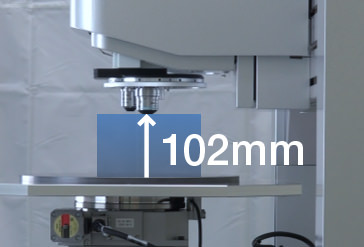
Max. workpiece Loading capacity 30kg
Stage options, worktop customization are available
Supports variable XY stage size
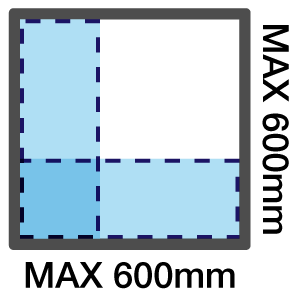
Passive vibration isolation table
xStores a PC and various axis control units

White light interference method enables swift measurement
Opt-Scope Rex uses the principle of white light interference for the swift, non-contact measurement of surface roughness and profile of objects such as machined mechanical parts. There is no longer a need for the XY axial scanning operation required by contact probe-type CMMs, so measurement is overwhelmingly fast and can be completed in a short time.

Proprietary method for detecting white light interference fringe peaks with DEAP
DEAP (Algorithm for Detection of Envelope and Absolute Phase) is an original algorithm devised by Tokyo ACCRETECH. DEAP offers a wider scope of measurement than PSI (phase shifting interferometry) and is capable of calculating envelopes at high sensitivity with higher resolution and a wider scope of measurement than VSI (vertical scanning interferometry). DEAP's ability to reduce measurement noise enables overwhelmingly better effective resolution, allowing clearer profile data when measuring slanted surfaces of machined mechanical parts that were a challenge to measure with conventional methods.
Specifications & Features

Features-1
The best choice for measuring roughness, defects, and fine contours of large workpieces
Maximum measurement height of 200 mm*. Adding a 130 mm column spacer (option) increases height to 330 mm. It offers sufficient measurement height even for large workpieces with jigs attached for securing the workpiece. It also accommodates a wide range of applications, from the analysis of 3D roughness, scratches, and wear of sliding surfaces such as bearings, profile evaluation of grinding wheels and carbide blades, to the detection of surface defects in semiconductor wafers. (in the case of Opt-scope S+)

Features-2
Improved measurement efficiency with auto focus and auto range functions
A high-speed camera option also significantly reduces scanning time
Opt-scope offers two outstanding features that enhance efficiency from pre-measurement preparation to measurement completion.
Auto focus function: A function that scans the target axis in an upward direction, automatically detecting interference fringe and adjusting focus. This significantly reduces the time required for focusing before measurement. In addition, users can choose either high-speed mode or high-sensitivity mode depending on the workpiece.
Auto range function: A function that can automatically optimize the measurement range in the Z direction, which was previously set uniformly, for each individual measurement point when measuring multiple points of a workpiece. This minimizes measurement time per point and significantly shortens the total measurement time, greatly increasing the efficiency of stitching measurement and the continuous measurement of wide areas.

Features-3
high-speed camera option Six times faster scanning speed*
2 modes to choose from depending on accuracy needs
High-speed mode is now even faster *When used at recommended pixel counts.

Features-4
Transparent multilayer film measurement function
This function can handle up to six transparent layers (seven interfaces) of film 1.5 µm or more in optical length and analyze the surface texture of the topmost surface, the film thickness of each layer, and film thickness distribution.
Opt-scope Rex - EYE
Opt-scope Rex is a large model 3D white light interference microscope that performs high-speed nano-level surface profile measurement utilizing "DEAP2," ACCRETECH's original high-speed, special-purpose detection algorithm. We spoke with two ACCRETECH engineers in charge of product development who maintain that "measuring instruments should evolve with customer input" about their thoughts on the product.

Tetsuji Kawagami
OPT Team Leader Coordinate Measuring Group, Engineering Division
Metrology Company

Yoshinori Nekozaki
Supervisor Coordinate Measuring Group, Engineering Division
Metrology Company
Please tell us about Opt-scope's features.
Kawagami
Opt-scope takes the place of conventional contact-type measuring instruments as a 3D surface roughness/contour measuring instrument capable of non-contact measurement. It enables tricky measurements, such as of minute workpieces that the stylus cannot pinpoint easily, soft workpieces, and hard workpieces which would otherwise damage the stylus.
With the conventional contact-type measuring instrument, the needle-like stylus would sometimes scratch mirror-finish products when performing tracing. Also, in order to evaluate roughness by surface rather than by line, surface data had to be prepared based on an immense volume of line data, which required the time-consuming process of repeating tracing over and over while slightly adjusting the measurement location. The Opt-scope series solves this issue of poor efficiency by obtaining data by surface rather than by line to significantly shorten measurement times. Since Opt-scope is a microscope type with adjustable lens magnification, users can make adjustments such as zooming in on measurement surfaces, performing wide-view verification, and switching resolutions required for analysis.
What has Opt-scope made possible?
Kawagami
Opt-scope has helped to dramatically improve quality control accuracy through 3D visualization of surface data. For example, in the case of products where scratches on a mirror surface is unacceptable, Opt-scope checks the location of scratches using 2D images, converts this to 3D data, then numerically evaluates the depth, width, and length of unacceptable scratches. Opt-scope can obtain data of the scratched areas and mirror surface area as part of a single surface, allowing a grasp of the overall problem and an accurate evaluation. With contact-type however, the problem would go unnoticed unless the instrument happened to trace the line along the scratch.
I understand that the performance of Opt-scope Rex is significantly higher than the conventional model.
Nekozaki
The stage now has a drive range of 400 to 600 mm instead of 25 to 50 mm, and allows a maximum workpiece weight of 30 kg. Opt-scope Rex supports measurement of a variety of workpieces, from minute precision parts to heavy workpieces such as molds.

Please tell us the background behind Rex's development.
Kawagami
When we began developing the Opt-scope series, we did so based on the premise of its application in minute workpiece measurement, and aimed to expand our user base to semiconductor industry players in addition to our existing customers in auto parts manufacturing. In 2020, we were approached by a manufacturer of machine parts for semiconductor manufacturing equipment. Although the Opt-scope product we had at the time offered sufficient measurement accuracy, the size and weight of the workpieces were too big and we began developing the large type, high-speed Rex. This was not a matter of simply enlarging the existing Opt-scope, and we also aimed to achieve high load capacity, high-speed movement, and high positional accuracy at the same time. In addition, we also decided to design the platform in anticipation of potential stroke expansion to accommodate individual requests for stage stroke changes in a short timeframe.
What did you struggle with the most during the development process?
Nekozaki
There were two challenges. The first was to maintain performance equivalent to the original regardless of changes in model design, and the second was that the client already planned to introduce the new model in seven months' time. There were no difficulties from a technical perspective, but it was a struggle to balance development with the tight schedule. In an effort to save time, we proceeded with the design of the stage and other large components simultaneously. In instances where we would usually complete Unit A before moving on to Unit B, we would begin designing Unit B once we finalized roughly half of the specifications for Unit A, which we repeated until we managed to complete it. To enable secure progress, we made sure that the respective project members kept close communication with each other to avoid confusion.
What kind of needs do you think will emerge in the market moving forward?
Kawagami
I think two major directions exist for the Opt-scope series. The first is its application in the semiconductor industry. The second large market is the various manufacturing industries connected to the electrification of cars, or EV. The EV field might have different workpieces to measure and might not even use the Opt-scope series, but we plan to develop new solutions to meet any new needs.
How do you want the Opt-scope series to evolve?
Kawagami
I think more and more customers will switch to the Opt-scope series from contact-type measuring instruments due to the newly established ISO and JIS specifications related to 3D surface roughness parameters. As a manufacturer of measuring instruments, ACCRETECH hopes to provide the necessary support for such customers.
Nekozaki
With the Opt-scope series, users should be able to analyze how their products wear, ascertain values for surface unevenness to realize optimal functionality, and determine evaluation criteria for previously undetected scratches. If 3D data can be accumulated and analyzed to identify causes, that should enable even higher quality manufacturing. We believe that measuring instruments should evolve with input from our customers. Our hope is to share in customer issues and make various analysis proposals so that we may contribute to improving quality.
Toward Even Better Monozukuri with Measurement as the First Step
Opt-scope Rex enables a wider range of high-accuracy measurements in less time. ACCRETECH will continue to support customers with its products to achieve an even higher level of monozukuri through measurement.














